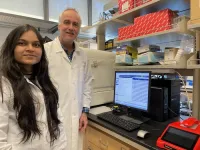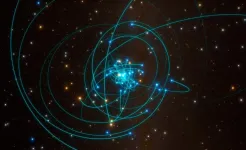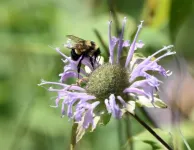(Press-News.org) RIVERSIDE, Calif. -- NeuroHIV refers to the effects of HIV infection on the brain or central nervous system and, to some extent, the spinal cord and peripheral nervous system. A collection of diseases, including neuropathy and dementia, neuroHIV can cause problems with memory and thinking and compromise our ability to live a normal life.
Using a mouse model of neuroHIV, a research team led by biomedical scientists at the University of California, Riverside, studied the effects of interferon-β (IFNβ), a small protein involved in cell signaling and integral to the body’s natural defense mechanism against viral infections. The researchers found that higher or lower than normal levels of IFNβ affect the brain in a sex-dependent fashion: some changes only occur in females, others only in males.
Marcus Kaul, a professor of biomedical sciences in the School of Medicine who led the study, explained that when infection-induced IFNβ levels become high, the brains of females and males are protected. If IFNβ production in response to infection is absent or too low, HIV can compromise brain function right away in both females and males, he said.
“However, IFNβ also controls other cell and brain functions,” Kaul said. “If IFNβ is absent, females display reduced nerve cell connections called dendrites in the cerebral cortex, while males show diminished ‘presynaptic terminals,’ another type of nerve cell connection, in the hippocampus.”
Dendrites are highly branched structures that increase the receptive surface of neurons.
“Paradoxically, in the hippocampus of females and males, the damage to presynaptic terminals by HIV is diminished when IFNβ is absent but the reduction of injury is more pronounced in males,” Kaul said.
According to the researchers, the work adds to scientists’ understanding of how innate immunity affects the brain during chronic HIV infection.
“Until now, it was not known that normal levels of IFNβ are required for normal memory function and that the absence of IFNβ changes the production of nerve cell components in a sex-dependent fashion,” Kaul said.
The findings, published in the journal Brain, Behavior, and Immunity, are noteworthy because the mouse model of neuroHIV that Kaul and his team used shares key features of brain injury and compromised function, such as impaired memory, with people living with HIV infection, or PLWH.
Almost all cells in the body can produce IFNβ. Kaul explained IFNβ regulates the production of inflammatory factors in neuroHIV and has two major effects: (a) it changes the state of a virally infected cell from ‘normal’ to ‘anti-viral,’ making the cells uncomfortable environments for the virus, even completely shutting down virus production, and (b) IFNβ is released from infected cells as well as specialized cells that, by sensing infected cells, can alert neighboring cells and the entire body of a viral infection.
“This is how neighboring cells adapt to become more resistant to viral infection,” Kaul said. “Some of them will also release additional anti-viral factors and a mixture of other factors that can promote or limit inflammation, such as cytokines called CCL3, CCL4 and CCL5.”
The research was performed in Kaul’s laboratory. The team generated a new variant of an established transgenic mouse model of neuroHIV by crossbreeding this model with mice that lack IFNβ. The team then analyzed memory function and brain tissue of the transgenic mice for injury that usually occurs in neuroHIV.
“HIV and some other viruses have developed mechanisms to reduce or even prevent the production of more than normal levels of IFNβ,” said Hina Singh, an assistant project scientist in Kaul’s lab and the first author of the research paper. “We know little about the role of IFNβ in the human brain beyond that it can reduce inflammation. This is a major reason why IFNβ is used to treat multiple sclerosis, an autoimmune disease that affects more than 2.8 million people worldwide. Currently, we have almost no information about how much IFNβ is present in the brains of PLWH and what it does there.”
Singh said the study underscores the importance of having normal levels of IFNβ during no viral infection and having sufficiently high levels of IFNβ in case of neuroHIV or other viral infections.
“The body’s many anti-viral responses observed in HIV infection are not specific to HIV but also occur with other viral infections,” she said. “But in contrast to most other viral infections, the body cannot get rid of HIV, which diminishes the effectiveness of the natural IFNβ response.”
Next, the team plans to work on confirming the findings of the neuroHIV model in PLWH.
“For this, we will need to investigate tissues of PLWH who consented to donate them for research after death,” Kaul said. “Ultimately, we hope to develop IFNβ into a therapy for patients with neuroHIV.”
The study was funded by grants to Kaul from the National Institutes of Health. Kaul and Singh were joined in the research by scientists at UCR and The Scripps Research Institute in La Jolla, California.
The title of the research paper is “Interferon-β deficiency alters brain response to chronic HIV-1 envelope protein exposure in a transgenic model of NeuroHIV.” The paper is scheduled to appear in print in May 2024.
Second related study
Another study from the Kaul lab is scheduled to appear in print in the May 2024 issue of Brain, Behavior, and Immunity.
“This study adds another important aspect to our understanding of how innate immunity and an inflammatory mechanism affects the brain during chronic HIV infection,” Kaul said.
The study shows that intact HIV and its viral envelope protein gp120 each cause macrophages, a type of white blood cell, to release cysteinyl leukotrienes, or CysLTs, which are pro-inflammatory mediators. The study shows for the first time that the CysLTs are critical components of macrophage neurotoxicity induced by HIV-1, the most common of the two major types of HIV.
“The potential translational value of our work is the demonstration that an asthma drug approved by the Food and Drug Administration, that inhibits a major receptor for CysLTs also prevents HIV-induced neurotoxicity,” Kaul said.
The research paper is titled “A critical role for Macrophage-derived Cysteinyl-Leukotrienes in HIV-1 induced neuronal injury.” Nina Yuan, a former associate specialist researcher in the Kaul lab, is the paper’s lead author. This study was supported by funds from the National Institute of Health.
The University of California, Riverside is a doctoral research university, a living laboratory for groundbreaking exploration of issues critical to Inland Southern California, the state and communities around the world. Reflecting California's diverse culture, UCR's enrollment is more than 26,000 students. The campus opened a medical school in 2013 and has reached the heart of the Coachella Valley by way of the UCR Palm Desert Center. The campus has an annual impact of more than $2.7 billion on the U.S. economy. To learn more, visit www.ucr.edu.
END
Small protein plays big role in chronic HIV infection
UC Riverside-led study on innate immune system may lead to new treatments for patients with neuroHIV
2024-04-04
ELSE PRESS RELEASES FROM THIS DATE:
Perinatal women of Mexican descent propose solutions to pandemic-related stressors affecting Latinos
2024-04-04
CHAMPAIGN, Ill. — Public policies blocked many families of Mexican descent living in the U.S. from accessing vital services such as food and mental health care during the COVID-19 pandemic, even though these communities experienced some of the highest infection and mortality rates.
Thirty-eight perinatal women and mothers of young children were interviewed about the challenges they faced during the pandemic and proposed solutions to better meet the needs of their communities during future large-scale crises in a study led by University of Illinois Urbana-Champaign kinesiology and community health ...
Novel biological mechanism discovered that could lead to new treatments for neurological disorders, cancers
2024-04-04
The lab of Yongchao C. Ma, PhD, at Stanley Manne Children’s Research Institute at Ann & Robert H. Lurie Children’s Hospital of Chicago discovered a fundamental biological mechanism that could lead to new treatments for neurological diseases, such as spinal muscular atrophy (SMA) and autism, as well as different cancers. The study was published in the journal Human Molecular Genetics.
Dr. Ma’s team found that chemical modification of RNA (called RNA methylation) regulates mitochondrial ...
Stellar collisions produce strange, zombie-like survivors
2024-04-04
Despite their ancient ages, some stars orbiting the Milky Way’s central supermassive black hole appear deceptively youthful. But unlike humans, who might appear rejuvenated from a fresh round of collagen injections, these stars look young for a much darker reason.
They ate their neighbors.
This is just one of the more peculiar findings from new Northwestern University research. Using a new model, astrophysicists traced the violent journeys of 1,000 simulated stars orbiting our galaxy’s central supermassive black hole, Sagittarius A* (Sgr A*).
So densely packed with stars, the region commonly experiences brutal stellar collisions. ...
Rusty-patched bumblebee’s struggle for survival found in its genes
2024-04-04
A team of researchers has uncovered alarming trends in the first range-wide genetic study of an endangered bee species. The study, led by Colorado State University and published in the Journal of Insect Science, will inform conservation and recovery efforts for the rusty-patched bumblebee – a species that was once common in the United States but has declined from about 90% of its historic range.
The rusty-patched bumblebee was the first bee species to be federally listed as endangered in 2017 through the U.S. Endangered Species Act. Its numbers dropped rapidly starting in the late 1990s, likely due to a combination of pesticides, ...
Research collaboration aims to enhance cereal crop resilience to acidic soils and improve agriculture sustainability
2024-04-04
ST. LOUIS, MO., April 4, 2024 — Acidic soil caused by changing climate patterns threatens agriculture sustainability across the globe. But the problem goes far beyond rising temperatures. One major cause for concern is more acidic soil, a product of increasing rainfall. Acidic soils with low pH are widespread globally and common in tropical and sub-tropical regions, where food security is a serious challenge. Climate change has exacerbated the problem. Acidic soil can result in aluminum toxicity, putting further stress on global agriculture. A new collaborative research team from the US and Brazil received a $2 ...
Introducing New York Valves: The Structural Heart Summit
2024-04-04
NEW YORK – April 4, 2024 – The Cardiovascular Research Foundation® (CRF®) is excited to introduce New York Valves: The Structural Heart Summit, the expanded next iteration of our renowned annual Transcatheter Valve Therapy (TVT®) conference. Taking place June 5-7, 2024, at the Jacob K. Javits Convention Center, North in New York City, the new summit will be a world-class educational experience in the field of structural heart interventions.
“New York Valves 2024 signifies an important milestone for our organization,” said Juan F. Granada, MD, President and Chief Executive Officer of CRF® and New York ...
"Drop industrial agriculture": Major study reports that people and environment both benefit from diversified farming, while bottom lines also thrive
2024-04-04
Mixing livestock and crops, integrating flower strips and trees, water and soil conservation and much more: Massive new global study led by the University of Copenhagen and University of Hohenheim, has examined the effects of diversified agriculture. The conclusion is abundantly clear – positive effects increase with every measure, while negative effects are hard to find.
Laura Vang Rasmussen of the University of Copenhagen can finally wipe the sweat from her brow. For the last four years, she has served as the link between 58 researchers on five continents and as lead author of a major agricultural study which gathered ...
Portable swept-source Raman spectrometer for chemical and biomedical applications
2024-04-04
In 1928, Indian physicist Sir C. V. Raman and his colleague K. S. Krishnan discovered that when light interacts with matter, parts of the scattered light undergo changes in energy due to interaction with molecular vibrations, resulting in what is known as Raman scattering. The discovery laid the foundation for Raman spectroscopy, a technique that takes advantage of these energy changes to create a unique fingerprint of the molecular structure of the material.
Currently, dispersive Raman spectroscopy ...
An hereditary liver disease cured with the help of gene scissors
2024-04-04
Argininosuccinate lyase deficiency (ASLD), also known as argininosuccinic aciduria, is a disease that has been enriched in the Finnish genetic heritage. In this severe metabolic disease, the body does not process proteins normally, instead resulting in a very dangerous accumulation of argininosuccinic acid and ammonia. Excess ammonia causes disturbances of consciousness, coma and even death.
In Finland, infants are screened for ASLD to determine the disease risk before symptoms develop. The treatment is an extremely ...
Dr. C. Barrett Bowling to be honored with the 2024 Thomas and Catherine Yoshikawa Outstanding Scientific Achievement in Clinical Investigation Award at #AGS24
2024-04-04
New York (April 4, 2024) — Today, the American Geriatrics Society (AGS) and the AGS Health in Aging Foundation (HiAF) announced that the 2024 Thomas and Catherine Yoshikawa Award for Outstanding Scientific Achievement in Clinical Investigation will be awarded to C. Barrett Bowling, MD, MSPH, Associate Professor in the Division of Geriatrics at Duke University School of Medicine.
The award will be presented at the AGS 2024 Virtual Annual Scientific Meeting (#AGS24), May 9-11 (pre-conference days May 7 & 8). At the conference, Dr. Bowling will deliver a lecture on “Geriatricizing” Chronic Disease Research: A Geriatrician’s ...
LAST 30 PRESS RELEASES:
Injectable breast ‘implant’ offers alternative to traditional surgeries
Neuroscientists devise formulas to measure multilingualism
New prostate cancer trial seeks to reduce toxicity without sacrificing efficacy
Geometry shapes life
A CRISPR screen reveals many previously unrecognized genes required for brain development and a new neurodevelopmental disorder
Hot flush treatment has anti-breast cancer activity, study finds
Securing AI systems against growing cybersecurity threats
Longest observation of an active solar region
Why nail-biting, procrastination and other self-sabotaging behaviors are rooted in survival instincts
Regional variations in mechanical properties of porcine leptomeninges
Artificial empathy in therapy and healthcare: advancements in interpersonal interaction technologies
Why some brains switch gears more efficiently than others
UVA’s Jundong Li wins ICDM’S 2025 Tao Li Award for data mining, machine learning
UVA’s low-power, high-performance computer power player Mircea Stan earns National Academy of Inventors fellowship
Not playing by the rules: USU researcher explores filamentous algae dynamics in rivers
Do our body clocks influence our risk of dementia?
Anthropologists offer new evidence of bipedalism in long-debated fossil discovery
Safer receipt paper from wood
Dosage-sensitive genes suggest no whole-genome duplications in ancestral angiosperm
First ancient human herpesvirus genomes document their deep history with humans
Why Some Bacteria Survive Antibiotics and How to Stop Them - New study reveals that bacteria can survive antibiotic treatment through two fundamentally different “shutdown modes”
UCLA study links scar healing to dangerous placenta condition
CHANGE-seq-BE finds off-target changes in the genome from base editors
The Journal of Nuclear Medicine Ahead-of-Print Tip Sheet: January 2, 2026
Delayed or absent first dose of measles, mumps, and rubella vaccination
Trends in US preterm birth rates by household income and race and ethnicity
Study identifies potential biomarker linked to progression and brain inflammation in multiple sclerosis
Many mothers in Norway do not show up for postnatal check-ups
Researchers want to find out why quick clay is so unstable
Superradiant spins show teamwork at the quantum scale
[Press-News.org] Small protein plays big role in chronic HIV infectionUC Riverside-led study on innate immune system may lead to new treatments for patients with neuroHIV






